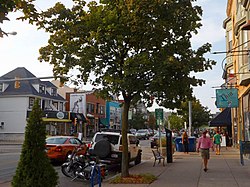Elmwood | |
|---|---|
Neighborhood | |
| Elmwood Village | |
 Elmwood Avenue | |
| Coordinates: 42°54′01″N78°52′39″W / 42.9003910°N 78.8774150°W | |
| Country | |
| State | |
| City | |
| Elevation | 643 ft (196 m) |
| Population (2010) | |
• Total | 30,774 |
| Time zone | Eastern (EST) |
| ZIP Code | 14201, 14202, 14209, 14213, 14222 |
| Area code | 716 |
| Website | Official website |
Elmwood Village is a neighborhood in Buffalo, New York. [1]

